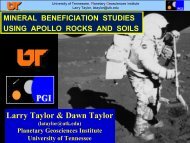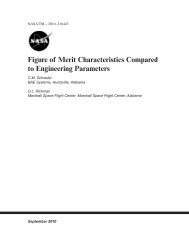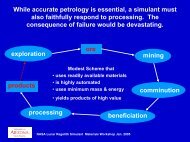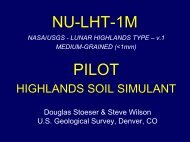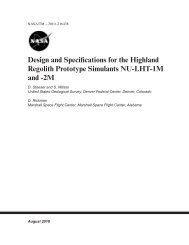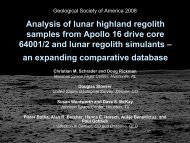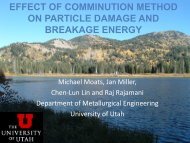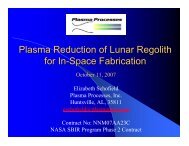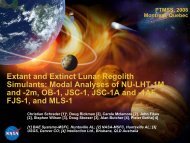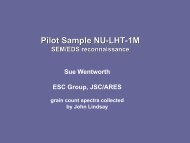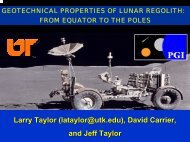Book of Abstracts- Lunar Regolith Simulant Materials Workshop
Book of Abstracts- Lunar Regolith Simulant Materials Workshop
Book of Abstracts- Lunar Regolith Simulant Materials Workshop
Create successful ePaper yourself
Turn your PDF publications into a flip-book with our unique Google optimized e-Paper software.
EVOLUTION OF THE LUNAR REGOLITH. David S. McKay, Johnson Space Center, Mail Code KA, Houston TX<br />
77058, david.s.mckay@nasa.gov<br />
Introduction: In order to properly design and produce<br />
simulants, it is necessary to have some insight<br />
into the evolution <strong>of</strong> the lunar regolith. In particular,<br />
the physical and engineering properties <strong>of</strong> the lunar<br />
regolith result from the complex processes that produce<br />
it and make it unique. In addition, the chemistry<br />
<strong>of</strong> the lunar regolith depends not only on the chemistry<br />
<strong>of</strong> the bedrock underlying it, but also on the evolution<br />
paths that produced it. In general, the chemistry <strong>of</strong> the<br />
regolith does not exactly correspond to the chemistry<br />
<strong>of</strong> the underlying bedrock. Furthermore, the chemistry<br />
<strong>of</strong> a given grain size fraction is likely to be different<br />
from that <strong>of</strong> another fraction. To understand these<br />
complexities, we must consider how lunar regolith has<br />
formed over geologic time.<br />
The lunar regolith. The lunar regolith is the<br />
fragmental layer that overlies nearly all rock formations<br />
on the moon. It varies in thickness from less than<br />
a meter in some areas to 10s <strong>of</strong> meters elsewhere. The<br />
maximum thickness is not known but is likely to be<br />
less than 100m and certainly less than 200m. Meteorite<br />
bombardment and secondary processes related to<br />
bombardment mainly produce the regolith. However<br />
the regolith is not simply ground up or milled bedrock.<br />
It is a dynamic material, sometimes becoming finer<br />
and other times becoming coarser in grain size. At any<br />
site the regolith may reach a steady state grain size but<br />
this grain size will likely differ from site to site. One<br />
type <strong>of</strong> regolith, represented by the black and orange<br />
glass at Apollo 17, is not the primary product <strong>of</strong> meteorite<br />
bombardment, but was produced by volcanic<br />
eruption <strong>of</strong> pyroclastic ash. In some places it constitutes<br />
the main regolith and is termed dark mantle.<br />
Dark mantle has many qualities that make it an attractive<br />
resource target for lunar propellant production.<br />
Typical lunar regolith contains rock fragments,<br />
mineral fragments, and glass. The primary glass type<br />
is agglutinates, which are constructional particles produced<br />
by small impacts. Because constructional particles<br />
are produced, the lunar regolith is not simply a<br />
product <strong>of</strong> grinding; its grain size distribution is much<br />
more complex. Figure 1 [1] shows the mean grain size<br />
and graphic standard deviation for 42 Apollo 17 soils.<br />
Finer Soils. These parameters show an inverse correlation;<br />
finer soils are better sorted. The maturity <strong>of</strong><br />
lunar soils was first defined by this figure based on<br />
grain size parameters. Maturity is an important parameter<br />
because it determines how much solar wind<br />
components (hydrogen, carbon, nitrogen, etc.) are present.<br />
Independent measurements <strong>of</strong> agglutinate content<br />
showed that more mature soils have more agglutinates.<br />
This correlation is also shown in Figure 2.<br />
Mature Soils. The most mature soils contain more<br />
than 60% agglutinates in the intermediate size fraction<br />
90-150µm. Extrapolation to 100% agglutinates would<br />
predict a mean grain size <strong>of</strong> 13µm. This is much finer<br />
grained than any Apollo soil; a soil this fine is unlikely<br />
5



